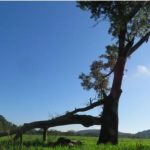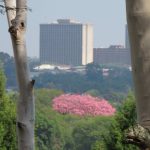TREE LIFE
FEBRUARY 2023
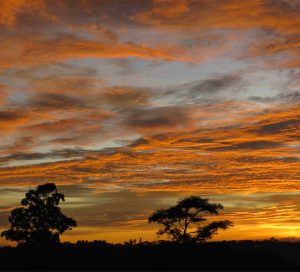
A glorious sunrise. Photo by Rob Jarvis.
Hi Everyone, Just thought I would kick off this Newsletter with this magnificent pre-sunrise view that greeted my early morning departure from home to work. The two trees could be juxtaposed, with acacias grown to provide firewood and the eucalypt told to stay at home. Of course, acacias are the homeless ones, not knowing if they are Vachellias or Senegalias.
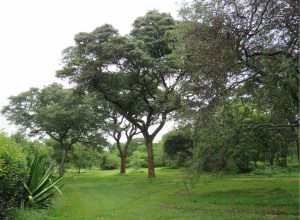
Msasas in the National Botanic Garden. Photo by Rob Jarvis
National Botanical Garden Outing
January 7th 2023
By Rob Jarvis
Rain threatened but luckily held off for the duration of our visit to the National Botanic Garden. Members came at spaced intervals and Meg was sent off in her chariot to get a head start. Eventually, there were 8 or so, with Mark, Tony and Meg leading the tree identification. We walked through the southern end of the premises and past the workshops until we arrived on the boundary with St George’s College grounds. There are some wonderful trees in this area, rarely visited by visitors to the Gardens. The musasas (left), make a grand glade just off the road. Schotia brachypetala, the Boer bean, was one of the first trees we noticed, but our intention was to continue looking at the various species of acacia in this area. However, it was a magnificent specimen and there was evidence of last season’s successful setting of pods. Ground and roasted, the beans make an excellent coffee substitute. We saw Acacia erubescens, a small multi-stemmed tree with reddening pods as they ripen, hence the specific name. The thorns are hooked and paired at every node. Acacia grandicornuta was also there with its grand horns of thorns. And Acacia kirkii, Acacia fleckii, Acacia schweinfurthii (scrambler) and the unrelated Senna singueana and Hexalobus monopetalus with its very shiny leaves.

Prickles left and ………… Spines or Thorns right
Photos by Jim Dryburgh
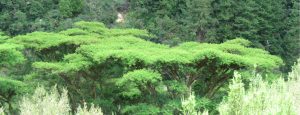
A lawn in the tree-tops. Photo by Rob Jarvis
Lawns do not have to be at ground level, sometimes tree-tops will suffice. Gairezi Cottages Photo: Rob Jarvis
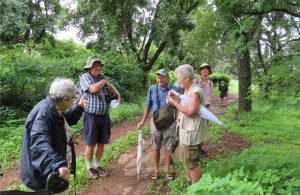
Which Acacia is this? Photo by Rob Jarvis
The rainy season is a very testing one for the Tree Society and members need to be well prepared with umbrellas and rain-coats, which when carried with camera, magnifying glass, handbooks on tree identification, water bottles, hats, make for much juggling when investigating bark, leaves, spines, thorns, pods, prickles and the like. Those who use ambulatory accessories are well-advised to seek up-market models capable of being wheeled through thick muddy terrain.
Right on the boundary with St. Georges, there is this magnificent specimen of Faidherbia albida. (See below left). Grown way out of its natural habitat at low altitudes
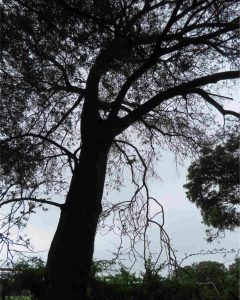
A Faidherbia albida in the Botanic Garden. Photo by Rob Jarvis
along riverine alluvium beds in the southern and Zambezi Valleys and western lowveld areas it is quite surprising to see it growing quite well here, in the Botanical Gardens. I know I have tried to grow them often at home and after a brisk start for 5 to 10 years they suddenly seem to succumb, probably to frost in the main, and their fresh winter foliage is seen no more. And in Harare they have no hope of becoming fodder for pachyderms, for the soft footfalls of those gentle giants disappeared well over a century ago from these parts. Nevertheless, as dead and dying tree trunks they have a role to play in the ecosystem providing a perch for avian raptors and a food source for bark-dwelling insects.
Proposed Tree Society Trip to Mafungautsi (Mafungabusi) Forest
Dates: 15 to 18 April 2023 The Mafungautsi (Mafungabusi) Forest is the largest of 21 State Forest Re-serves (82 100 Hectares) South of Gokwe. There are many interesting-looking areas within the forest and along the rivers, as well as some vlei margins.
Plan: Travel to Gokwe on 15 April on the Kwekwe/Gokwe Rd in convoy, stopping to look at areas of interest. (353 Km) Accommodation for the trip: Pumba Safaris located on the Gokwe Nembudziya junction. Rooms vary between USD 20 to USD 50 and all are en suite. There are also self-catering cottages. There are no suitable facilities for camping with a group within the Forest area and the Forestry Commission have recommended using Pumba Safaris.
Catering: To be discussed among the groups travelling
Activities: Drive into Forest on 16 and 17 April to identify areas of interest, and back to Gokwe accommodation each evening. (The Forest starts within 10km of Gokwe and the Forestry Commission HQ is 35km from Gokwe) Travel back to Harare on 18 April in a convoy. The road to Gokwe is in reasonable condition; however, the trips into the Forest areas will definitely require 4×4. Transport arrangements can be discussed among the group.
Please let me know soon if interested, I need to reserve the accommodation with PUMBA Safaris (https://pumba-safari-lodge.business.site/). I can send photos of the rooms and Lodge to those who are interested.
Frances (franlovemore@gmail.com) +263772308544
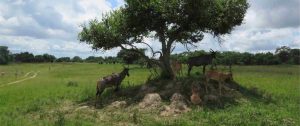
Animals in shade. Photo by Rob Jarvis
Advance Notice of Proposed Tree Society Visit to Kanyemba
Dates: 2nd to 6th November 2023.
Kanyemba is situated on the Zambezi River, as it flows into Cabora Bassa, and is the border post between Zimbabwe, Zambia and Mozambique. Up river from Kanyemba are the Red Cliffs, and further upstream, Mapata Gorge. The whole area is of botanical interest.
Masau Lodge (https://masaulodge.com/) has accommodation for up to 20 people (16 ideally) and has reserved a booking for the Tree Society for these dates. November has been selected as ideal for tree identification (although it will be warm). Masau Lodge has boats for hire, to get up the river and explore the banks and tributaries, and to the gorge.
Itinerary: The proposed itinerary is to travel to Kanyemba (4×4 vehicles necessary) in convoy, leaving Harare early on the morning of the 2nd November and stopping at several points of botanical interest on the way. Under good conditions, with no stops, the journey is over 6 hours (386 km). The days of the 3rd 4th and 5th will be spent exploring and recording, interspersed with activities of entertainment, and then travel back to Harare, via Mutota’s Sacred Baobab (No 36 in Lyn Mullin’s ‘Historic Trees of Zimbabwe’) and “Dzimbabwe” (on the Mahuwi Fly Gate/ Muzarabani Road). The vegetation within the ancient ruins has been preserved and is somewhat different to the surrounding area. The journey in convoy will then travel back up the Alpha Trail and through Centenary back to Harare.
Catering: The Lodge is self-catering, with a cook provided and a large communal dining area, so all meals will be catered and prepared (with consideration to all dietary requirements).
Costs: The approximate cost per person including accommodation, food and boat trips up to the Gorge and exploring the riverine is about USD 350 per person. Transport is excluded and will be paid separately to the drivers. We have to put a deposit of USD 1000 down fairly soon, as November is the peak season for the camp. Unfortunately, the costs are fairly high, but it is a unique opportunity to explore this area with Mark and Meg. Please let Frances Morris know as soon as possible if you are interested in this trip to enable us to make a firm booking.
franlovemore@gmail.com WhatsApp +263772308544
Trees of the Month: Erythrina spp. By Rob Jarvis
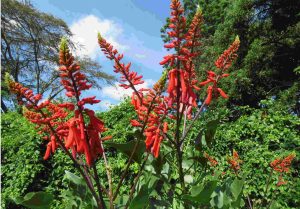
Erythrinas in flower. Photo by Rob Jarvis
What grand trees the erythrinas make, usually flowering in the spring, often on deciduous trees devoid of leaf and hereabouts in Central Africa they usually have bright red inflorescences. They resemble the aloes in impact and usually come out just after all the winter-flowering aloes have finished their spectacular show over the period May, June and July. And when you see the bright crimson flowers of the erythrinas dotted around the landscape, you know that the hot dry months that precede the start of the rains are well and truly here and that the thunderstorm season looms.
In a way, I always think that erythrinas fit the role of the oak in our southern sub-tropical climates. They are very well and broadly adapted, perfectly suited to the single rainy season that we experience, losing their leaves in the dry winter months and exposing thereby the dramatic structure of well-formed trees, especially when they grow as solitary specimens on the windswept, highveld grasslands of the watershed. Birds and insects love them, and soon after their rich, nectar-filled flowers finish, the trees burst into bright, fresh tri-foliate leaf growth. So in winter, they let in the sun and in summer they have the perfect shade.
Some species have beautiful deeply fissured corky bark, home to many crawling and wood-boring creatures and the relatively soft wood is easily pecked out for woodpeckers, barbets and insect holes. In this respect, they are not oak-like at all. Easily grown from seed, they make good subjects for bonsai plants, despite the relatively large size of their leaves and even whole branches and truncheons can be plonked with confidence in the ground and they will take easily and become a tree in a very short period of time.
Others, like E. zeyheri are largely underground trees with a massive trunk hidden below the soil surface and are commonly known as plough-breakers.
The one pictured above is growing on our Close in Rolf Valley, from seed obtained from friends with a lodge in Inhasoro in Mozambique. We welcome any informed ideas on exactly what species it is.
TREE SOCIETY COMMITTEE AND CONTACTS
Chairman Tony Alegria tonyalegria47@gmail.com 0772 438 697
Vice Chairman Rob Jarvis bo.hoom52@yahoo.com 0783 383 214
Honorary Treasurer Bill Clarke wrc@mweb.co.zw 0772 252 720
Committee member Jan van Bel jan_vanbel@yahoo.com 0772 440 287
Venue Organiser Ann Sinclair jimandannsincs@zol.co.zw 0772 433 125
Committee member Ryan Truscott ryan.kerr.truscott@gmail.com 0772 354 144
Secretary Teig Howson teig.howson@gmail.com 0772 256 364
Tree Society Website https://treesociety.org.zw/
Tree Society Facebook https://www.facebook.com/groups/ztreesociety/
Flora of Zimbabwe: https://www.zimbabweflora.co.zw/
Flora of Tropical Africa: https://plants.jstor.org/collection/FLOTA
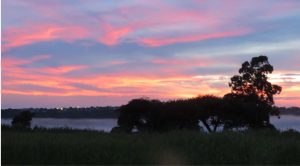
Sunset. Photo by Rob Jarvis


